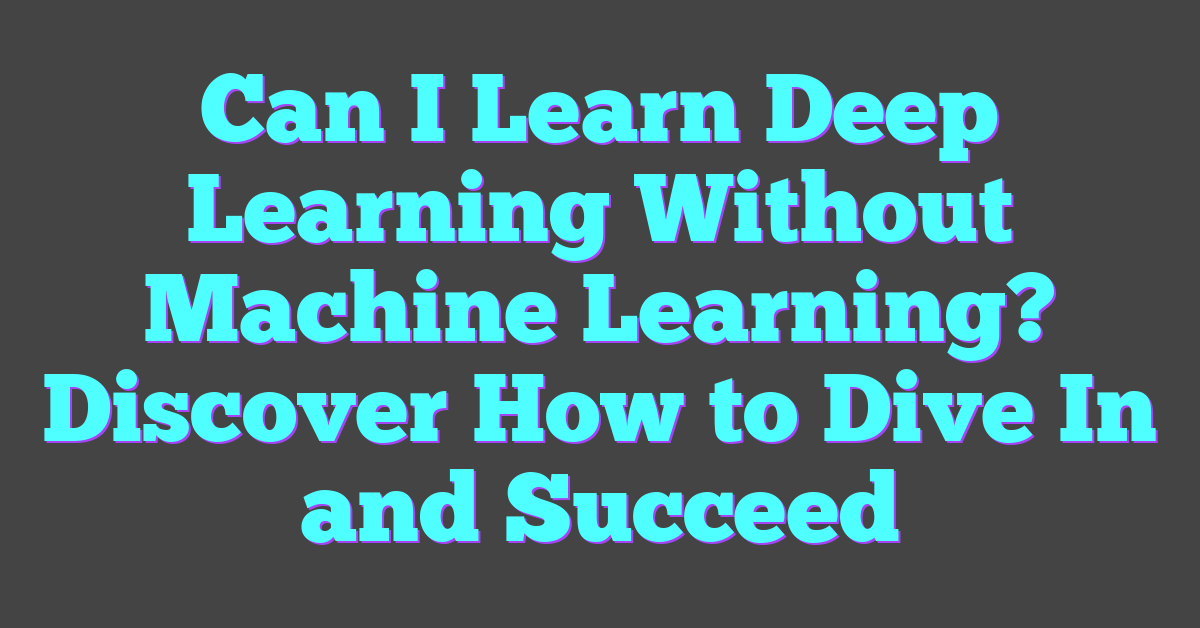Curious about diving into deep learning but unsure if you need a background in machine learning first? You’re not alone. Many aspiring data scientists and tech enthusiasts wonder if they can skip straight to the fascinating world of neural networks and advanced algorithms without the foundational knowledge of machine learning.
While deep learning is a subset of machine learning, it’s possible to start learning it directly. However, understanding the basics of machine learning can provide a smoother and more comprehensive learning experience. Let’s explore whether you can embark on this exciting journey without the prerequisite of machine learning and what you might need to succeed.
Understanding Deep Learning and Machine Learning
Deep learning and machine learning are fundamental concepts within artificial intelligence (AI). While related, they have distinct characteristics and applications that set them apart.

What Is Deep Learning?
Deep learning is a subfield of machine learning focusing on neural networks with many layers. These layers enable deep learning models to automatically discover representations from data without manual feature extraction. For example, convolutional neural networks (CNNs) excel in image recognition, while recurrent neural networks (RNNs) are effective for sequence data like text and speech.
Deep learning models learn from vast amounts of data, adjusting weights through backpropagation to minimize error. With large datasets, such as those used in natural language processing (NLP) or autonomous driving, deep learning can achieve remarkable accuracy. However, building and training these models often requires significant computational power.
What Is Machine Learning?
Machine learning, a broader field encompassing deep learning, involves algorithms that enable systems to learn from data. Unlike traditional programming, where rules are explicitly coded, machine learning models learn patterns and relationships from input data. Examples include regression for predicting continuous values and classification for categorizing data points.
Supervised learning trains models on labeled data, while unsupervised learning identifies patterns in unlabeled datasets. Reinforcement learning, another key area, involves training agents to make decisions through trial and error, optimizing for cumulative rewards. Classic algorithms like decision trees, support vector machines (SVMs), and k-nearest neighbors (KNN) are integral to this field.
Relationship Between Deep Learning and Machine Learning
Deep learning (DL) and machine learning (ML) are interconnected fields in artificial intelligence. Comprehending their relationship helps in making advancements in AI.
How Deep Learning Relies on Machine Learning Concepts
DL uses several foundational ML concepts as its basis. Neural networks, an essential DL tool, build upon the idea of hierarchically structured data features. Foundational ML techniques, like supervised learning, enable DL models to process labeled data, ensuring accuracy in tasks like image recognition.
Learning algorithms such as gradient descent, backpropagation, and regularization, form the backbone of DL. Without these ML-driven methods, training DL models would be inefficient and ineffective. Hence, even if one begins with DL, understanding ML principles accelerates progress.
Distinct Characteristics of Deep Learning
DL distinguishes itself through its architecture and data processing capabilities. Unlike traditional ML, which often relies on human-engineered features, DL models like Convolutional Neural Networks (CNNs) and Recurrent Neural Networks (RNNs) automatically extract hierarchical features from raw data.
DL excels in handling large datasets and complex data types such as images, text, and audio. For example, CNNs revolutionized image classification by reducing the need for manual feature extraction. The depth of neural networks in DL, featuring multiple hidden layers, allows for more intricate pattern recognition and decision-making.
DL’s ability to generalize and improve with more data makes it a powerful tool in AI, differentiating it significantly from broader ML methods.
Possibility of Skipping Machine Learning
Some believe that diving directly into deep learning without a machine learning background is feasible, given deep learning’s powerful architectures that autonomously extract features from data. Understanding this possibility requires examining the underlying challenges and expert views.
Challenges of Bypassing Fundamental Concepts
Deep learning hinges on concepts rooted in machine learning, such as neural networks and supervised learning. Without understanding these fundamentals, grasping how deep learning processes data, uses algorithms like gradient descent, and trains models might be difficult. Core principles like overfitting, regularization, and bias-variance tradeoff play crucial roles in successful deep learning applications. Ignoring these elements could lead to significant inefficiencies and misunderstanding of model behavior.
Perspectives from Experts
Experts acknowledge that while it’s technically possible to start with deep learning, having a machine learning foundation offers a deeper comprehension of core principles. Andrew Ng, a renowned AI researcher, emphasizes the value of mastering machine learning to build a solid basis for tackling more complex deep learning challenges. Yann LeCun, a pioneer in the field, stresses the importance of understanding traditional machine learning to truly appreciate and innovate within deep learning.
By juxtaposing both fields, experts advocate a balanced approach. While deep learning’s powerful capabilities are tempting to jump into, the foundational knowledge from machine learning often accelerates and enhances the learning process in the long run.
Benefits of Learning Machine Learning First
Learning machine learning before diving into deep learning provides several advantages, ensuring a smoother and more effective learning journey in AI.
Building a Strong Foundation
Understanding machine learning principles establishes a solid foundation. Fundamental concepts like supervised learning, unsupervised learning, and reinforcement learning form the basis for deep learning techniques. For example, knowledge of linear regression and decision trees aids in grasping neural networks’ operations. Without this background, deep learning principles may appear abstract and harder to comprehend.
Enhanced Problem-Solving Skills in Deep Learning
Machine learning experience enhances problem-solving skills, benefiting deep learning endeavors. Machine learning algorithms like support vector machines (SVMs) and k-means clustering teach valuable problem-solving methodologies. For instance, familiarity with overfitting and regularization enables more effective tuning of deep learning models. With these skills, practitioners can develop and troubleshoot complex deep learning architectures more efficiently.
Successful Examples of Learning Deep Learning Directly
Numerous instances prove that learning deep learning directly, without a strong background in machine learning, is possible. These examples demonstrate how dedication, access to resources, and practical experience can fast-track one’s proficiency in deep learning.
Case Studies and Anecdotes
Several successful self-taught deep learning practitioners have made significant contributions to the field despite lacking formal machine learning education. Andrew Ng’s “Deep Learning Specialization” on Coursera has several alumni who began without machine learning knowledge but achieved substantial expertise by focusing exclusively on deep learning. One learner, who initially struggled with machine learning concepts, excelled in deep learning through hands-on projects and dedicated study. These individuals often highlight the importance of practical application, leveraging projects, and real-world datasets to solidify their understanding of deep learning principles.
What Makes Direct Learning Possible?
Access to structured online courses and quality resources enables direct learning in deep learning. Comprehensive courses like Stanford’s CS231n and fast.ai’s “Practical Deep Learning for Coders” provide materials and support comparable to traditional machine learning courses. The sequential and project-based nature of these courses allows learners to grasp complex topics incrementally.
Modern libraries and frameworks simplify the implementation of deep learning models. Libraries like TensorFlow, Keras, and PyTorch offer pre-built functions to streamline model creation. As a result, learners can focus on understanding and refining deep learning techniques without extensive programming proficiency.
Community support and collaboration drive rapid learning. Platforms like Stack Overflow, GitHub, and specialized AI forums enable learners to seek help, share insights, and collaborate on projects. Engaging with a community fosters a deeper understanding and accelerates problem-solving skills in deep learning tasks.
Conclusion
While a foundation in machine learning can certainly ease the journey into deep learning, it’s not an absolute necessity. With dedication, practical experience, and the wealth of resources available today, anyone can dive straight into deep learning. Real-world projects and community support play crucial roles in mastering this complex field. So whether one chooses to start with machine learning or jump directly into deep learning, the key is to stay curious and keep experimenting.
Frequently Asked Questions
What is the difference between deep learning and machine learning?
Deep learning is a subset of machine learning that focuses on using neural networks with many layers to analyze data. Machine learning encompasses a broader range of algorithms that can be used for predictions and patterns in data, including both simpler and more complex models like deep learning.
Do I need to understand machine learning before learning deep learning?
While understanding machine learning principles is beneficial and recommended, the article highlights that it is possible to learn deep learning directly with dedication, practical experience, and access to structured online courses.
What are some key foundational concepts in machine learning?
Key foundational concepts in machine learning include supervised learning, where models learn from labeled data, and reinforcement learning, where models learn through trial and error by receiving rewards or penalties.
Can beginners learn deep learning without prior experience in machine learning?
Yes, beginners can learn deep learning without prior experience in machine learning. The article showcases successful examples of individuals who have done so through practical experience, hands-on projects, and utilizing structured online courses.
How can hands-on projects and real-world datasets enhance understanding in deep learning?
Hands-on projects and real-world datasets provide practical experience, helping learners apply theoretical knowledge, understand real-world challenges, and build practical skills essential for proficiency in complex deep learning tasks.
Are there resources available for learning deep learning directly?
Yes, there are comprehensive online courses, modern libraries, and community support available that enable learners to directly dive into deep learning and gain practical knowledge and skills.
Why is practical application important in learning deep learning?
Practical application is crucial because it helps reinforce theoretical concepts, allows learners to tackle real-world problems, and builds a deeper understanding and proficiency in deep learning tasks.
What role does community support play in learning deep learning?
Community support provides learners with access to shared knowledge, troubleshooting assistance, and collaborative opportunities, which can significantly accelerate the learning process and enhance problem-solving skills in deep learning.




